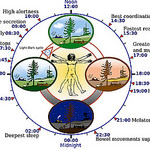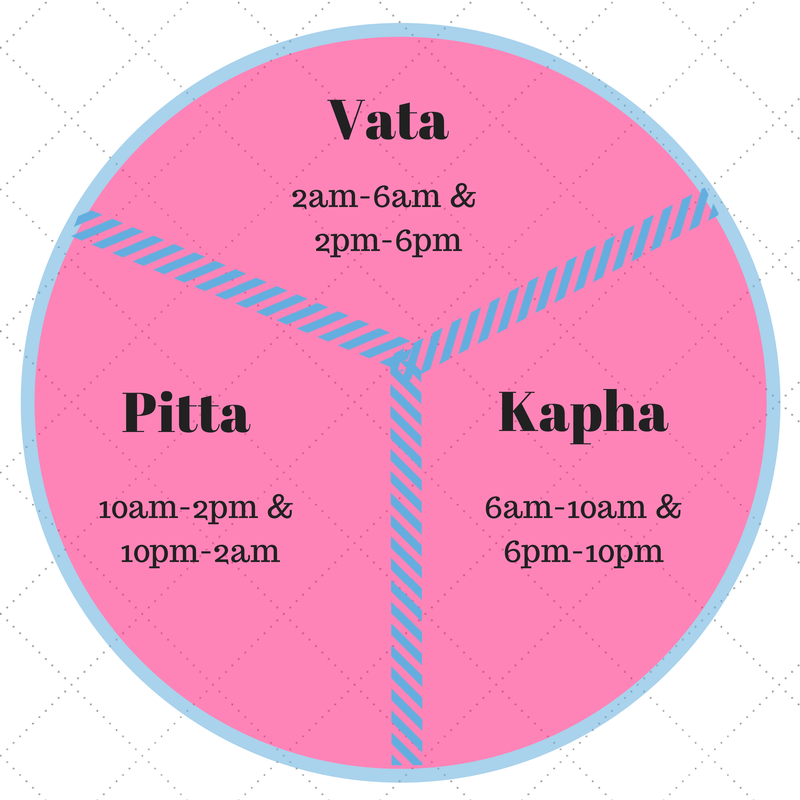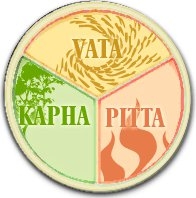Have you ever felt exhausted in the middle of the afternoon? Have you ever had a hard time getting out of bed in the morning, even though you thought you were getting enough sleep? Do you have a hard time losing weight, even though you’re dieting and exercising?
Something interesting has been happening to me over the past few weeks and it ties directly into the answer to the questions above.
As many of you know, I moved from Tucson, AZ and am staying with my family in Cleveland, OH for a few weeks before continuing on with my journey to Washington DC.
What I’ve noticed is that I’ve had a really hard time getting into a routine in Ohio, and I have a few suspicions as to why that is.
But first, let me introduce you to an Ayurvedic principle about energy that I think you’ll find interesting and relevant.
The foundation of Ayurveda
In Ayurveda, everything is constituted of five elements. We call the combination of these elements the doshas and they represent physical and mental archetypes that we all display in a unique formulation. This uniqueness is what makes you who you are. But this combination of elements and these doshic qualities can also be applied to other systems outside the body and mind.
For example, each place has a predominant doshic quality, as do the seasons and even certain hours of the day.
Let me give you concrete examples so you can get a better grasp on what I’m talking about.
You’re probably familiar with most of the five elements that Ayurveda draws from. Those elements are:
- Ether
- Air
- Fire
- Water
- Earth
Ether is probably the one you’re least familiar with – it represents space. If you think about it, everything is made up of space. There is space all around us (some places have more space than others).
The three doshas that I referred to earlier are:
- Pitta (a combination of the elements fire and water)
- Vata (a combination of the elements ether and air)
- Kapha (a combination of the elements earth and water)
If you think about the element fire, it has the power to transform. It’s energy is consuming and intense. It gives off a lot of heat and it has a lot of power to change things. It also needs water to temper it down, lest it rage out of control. Over time, if a fire is left untended, it will burn itself out.
The element air represents movement. Think about the wind on a cool Autumn day – the rustling of leaves and the feeling of that crisp breeze on your exposed skin. The wind can change abruptly and it needs space to move through.
When you think about earth and water together, you get mud – a sticky substance that moves slowly and is hard to wade through. Earth on it’s own is stable and strong (think mountains and the solidity of rocks).
The qualities of these combination of elements explain a lot about ourselves and our tendencies but also about space and time.
The energetic qualities of Space
Think about New York City, Phoenix, Arizona and Cleveland, Ohio. New York City has a Vata energy about it. There is constant movement. Phoenix, Arizona is hot and dry and has a Pitta quality about it. And finally, Cleveland, Ohio, which moves at a moderate pace, somewhere in between the changing winds of Vata and the intensity of Pitta has a Kapha quality about it. Slow and steady wins the race. Moderation is key.
The energy of the space you’re in can have an effect on your own energy levels and patterns. The ultimate goal of Ayurveda is to live in balance with your dosha and your environment; however, to do this you must be aware how certain qualities affect your dosha. In Ayurveda, you need less of what you already have to help you find balance; in other words, if you are a Pitta person (me) living in Arizona (which I was), the heat is increasing your already hot and fiery nature and you have to be extra careful to stay in balance. If you are a Kapha person and live in a Kapha place, you have to be extra careful to seek out stimulating activity lest you fall prey to couch-potato syndrome.
Now that you know a little bit about how Ayurvedic energy works on a personal and space level, let’s swing back around and talk about time.
The energetic qualities of Time
 Each time of the day has an energy about it. In Western science we call this the Circadian Rhythm, which you’ve probably heard of before. In Ayurveda, we use the qualities of the elements to describe different times of the day
Each time of the day has an energy about it. In Western science we call this the Circadian Rhythm, which you’ve probably heard of before. In Ayurveda, we use the qualities of the elements to describe different times of the day
- 10pm-2am and 10am-2pm are considered Pitta times of the day
- 2am-6am and 2pm-6pm are considered Vata times of the day
- 6am-10am and 6pm-10pm are considered Kapha times of the day
Let’s look at how these energies affect each of these times. Remember, Pitta is the energy of transformation and also of metabolism. The fire in Pitta corresponds directly with our ability to digest food and extract the nutrients from our food to transform our bodies. If you have a deficiency of Pitta, that means your digestion is probably weak. During Pitta times of the day, your digestive power is at it’s greatest. This is why in Ayurveda (and many cultures, for that matter), the largest meal of the day is eaten at mid-day between that 10am-2pm time frame when we’re best able to digest heavy meals. When you look at when most Americans eat their largest and heaviest meal of the day, it’s right in that Kapha time frame when our digestion is slowest.
You might argue that the body goes back into a Pitta time in the evening, so it shouldn’t matter how large a meal we eat at night, but food isn’t the only thing the body has to digest. In the evening Pitta time, the body starts to digest mental energy and the body’s repair mechanisms turn on as we sleep. That is why in Ayurveda it’s best to be in bed and resting from 10pm-2am so that the body can have the time it needs to do all this transforming and metabolizing on the inside. Plus, that fire needs a chance to rest, lest we burn out.
Remember how I asked if you’ve ever had a hard time getting out of bed in the morning, even when you think you’re getting enough sleep? Well, in Ayurveda, when you look at the times of day, you’ll see that once we hit 6am, we’re in a Kapha time of day – the slowest, groggiest time of day, and also the hardest time of the day to get motivated! In Ayurveda, it’s recommended to rise before the sun, which is often right around that 6am mark (Daylight Savings Time ruined the natural cycles, so we have to take that into consideration now). In Arizona, where they don’t recognize Daylight Savings Time, the sun would rise around 5:30am. Getting up around this time ensures you’re getting up before the Kapha time hits and for most people, depending on what time you went to sleep and your own doshic constitution, you’ll amazingly find that waking up before 6am is easier then you imagined.
Think about it. Have you ever woken up in the middle of the night between 2-6am wide awake? Perhaps your mind was running wild with ideas or you were worried about something coming up at work? This is representative of Vata, which largely resides in the mind. When we look at Western medical science and the stages of sleep, it’s during those last stages of sleep (REM Sleep) that we get the craziest dreams. We know from research that if we get up before our sleep stages are complete, we’ll most likely not feel energized upon waking.
Vata energy also corresponds with creativity and cognitive ability. This is why the afternoon period between 2pm-6pm is a great time for brainstorming and creative projects. It’s also the best time to meditate, because we’re better able to access and control our mental abilities. If you get up before 6am and meditate, which is what Ayurveda recommends, you’ve set yourself up for a really successful day.
Finally, the Kapha times of the day. Kapha energy is the slowest and needs the most motivation. From 6am-10am when we’re getting ready for our day, it’s a great time to workout and get the stimulation that your body needs to move throughout the rest of the day with ease and energy. In the evening, it’s a good time to start to slow down and get ready for bed.
You can see then each time span honors one of the two aspects of each doshic quality. In the evening Pitta needs to calm down, but in the middle of the day, Pitta energy is at its highest and that can be an intense time. In the morning, Kapha energy needs to be stimulated but in the evening, the slow and peaceful qualities need to be honored. And for Vata, the morning is about resting and the afternoon is about using that mental energy in a focused and efficient manner.
When you overlay the doshas with time, space and personal constitution, the puzzle pieces of balance start to all fall in place, although it’s a complicated puzzle for sure.
Getting back into your own rhythm
I’ll circle back to my own story. I know that I’m easily swayed by the energy around me. That’s a Vata quality. My personal doshic constitution is Pitta-Vata. When I was living in Arizona, I didn’t love it because the heat bothered my Pitta constitution and I had to be extra careful to not overdo it. The dryness of the desert really bothered my Vata.
Now that I’m in Ohio, I’m in a very Kapha place and I feel that all around me. While my skin feels better and I feel cooler, it’s much harder to get motivated. I’m also living with and around different people with different constitutions and this has switched up my schedule. My family eats their largest meal of the day at 6:30pm. I’ve tried hard to stick to my routine but it’s difficult to get motivated with all that Kapha energy around me!
When you start to understand who you are and what is around you, you’re able to understand on a more subtle level what’s going on in your life. Rather then get frustrated when you can’t get motivated, look to your schedule, the place you’re in and who you’re around to help you make the most effective decision about what needs to change so that you can feel at your best.
It could be as simple as going to bed 15 minutes earlier or as complicated as switching your biggest meal of the day to lunch (believe me, I’ve been trying this and it’s HARD). Or it might not be hard for you at all, and that’s the beauty of Ayurveda. It’s an individualized and unique system that honors you as a person rather than the systems that we’re supposed to fit into. Even though I might find the Kapha energy of Cleveland to be demotivating, someone else might find it a great place to thrive.
Start paying attention to your energy levels, how you’re feeling at different time of the day and start to become aware of your own daily habits and lifestyle patterns. Are you living in alignment with your body’s natural Circadian Rhythm or the Ayurvedic rhythm of life?
Let me know what you think about all this over on the Facebook page! I can’t wait to hear what you find out about yourself after some observation.
photo credits: Circadian Rhythm – vaXzine






